VLAN Questions 3
Here you will find answers to VLAN Questions – Part 3
Question 1
Refer to the exhibit. On the basis of the output generated by the show commands, which two statements are true? (Choose two)
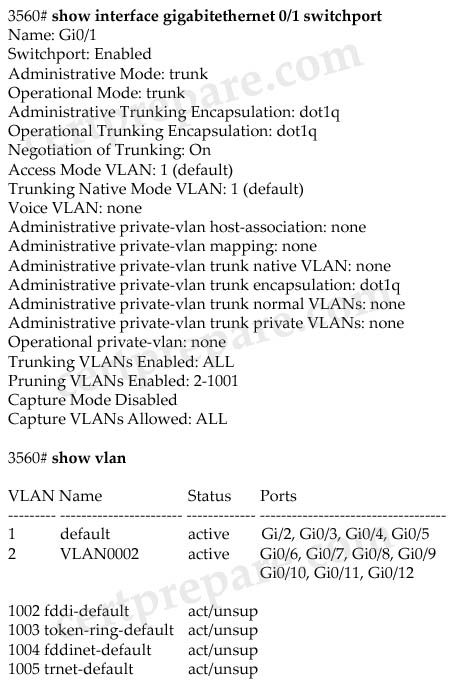
A. Interface gigabitethernet 0/1 has been configured as Layer 3 ports.
B. Interface gigabitethernet 0/1 does not appear in the show vlan output because switchport is enabled.
C. Interface gigabitethernet 0/1 does not appear in the show vlan output because it is configured as a trunk interface.
D. VLAN2 has been configured as the native VLAN for the 802.1q trunk on interface gigabitethernet 0/1.
E. Traffic on VLAN 1 that is sent out gigabitethernet 0/1 will have an 802.1q header applied.
F. Traffic on VLAN 2 that is sent out gigabitethernet 0/1 will have an 802.1q header applied.
Answer: C F
Explanation
From the output of show interface gigabitethernet 0/1 switchport command we can see this port is currently configured as trunked port (Operational Mode: trunk) and uses 802.1q encapsulation. So surely the “show vlan” command will not list this port -> C is correct.
Also from the first output we learned the native VLAN is VLAN 1 (Trunking Native Mode VLAN:1) so only traffic from this VLAN is sent untagged -> traffic sent from VLAN 2 out this port will have an 802.1q header applied -> F is correct.
Question 2
When you issue a command show port 3/1 on an Ethernet port, you observe the ‘Giants’ column has a non-zero entry. What could cause of this?
A. IEEE 802.1Q
B. IEEE 802.10
C. Misconfigured NIC
D. User configuration
E. All of the above
Answer: A
Explanation
Generally, frames that are greater than 1522 bytes are categorized as giant frames (notice that a normal Ethernet frame has a size that ranges from 64 bytes to 1518 bytes). Giant frames often are the result of some protocol-tagging mechanisms, for example 802.1Q frames (1522 bytes), MPLS (1518 + 4 * n, where n is the number of stacked labels), ISL frames (1548 bytes).
There are nothing wrong with giant frames, just make sure you configure both end devices to support these frames.
Note: In fact, frames that are created by 802.1Q are often known as baby giants (frames that are slightly larger than 1518 bytes).
Question 3
You want to configure a switched internetwork with multiple VLANs as shown above. Which of the following commands should you issue on SwitchA for the port connected to SwitchB?
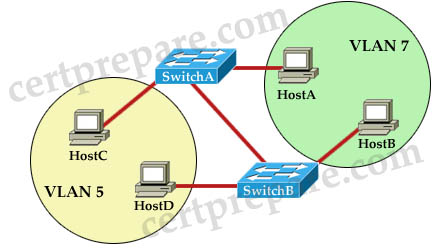
A. switchport mode trunk
B. switchport access vlan 5
C. switchport mode access vlan 5
D. switchport trunk native vlan 5
Answer: A
Explanation
To support interVLAN routing, the links between two switches must be configured as trunk link.
Question 4
Refer to the exhibit. VLAN 1 and VLAN 2 are configured on the trunked links between Switch A and Switch B. Port Fa 0/2 on Switch B is currently in a blocking state for both VLANs. What should be done to load balance VLAN traffic between Switch A and Switch B?

A. Lower the port priority for VLAN 1 on port 0/1 for Switch A.
B. Lower the port priority for VLAN 1 on port 0/2 for Switch A.
C. Make the bridge ID of Switch B lower than the ID of Switch A.
D. Enable HSRP on the access ports.
Answer: B
Explanation
Please read the explanation of Question 3 in https://www.certprepare.com/vlan-questions-4.
In general, a BPDU is superior than another if it has:
1. A lower Root Bridge ID
2. A lower path cost to the Root
3. A lower Sending Bridge ID
4. A lower Sending Port ID
These four parameters are examined in order. In this specific case, all the BPDUs sent by Switch A have the same Root Bridge ID, the same path cost to the Root and the same Sending Bridge ID. The only parameter left to select the best one is the Sending Port ID (Port ID = port priority + port index). Which port Switch B will block is based on the Sending Bridge ID it receives from Switch A. So lower the port priority for VLAN 1 will lower the Sending Bridge ID for port Fa0/2 on Switch A -> traffic for VLAN 1 will flow via Fa0/2 link.
Question 5
On a multilayer Catalyst switch, which interface command is used to convert a Layer 3 interface to a Layer 2 interface?
A. switchport access vlan vlan-id
B. switchport
C. switchport mode access
D. no switchport
Answer: B
Question 6
Refer to the exhibit and the show interfaces fastethernet0/1 switchport outputs. Users in VLAN 5 on switch SW_A complain that they do not have connectivity to the users in VLAN 5 on switch SW_B. What should be done to fix the problem?
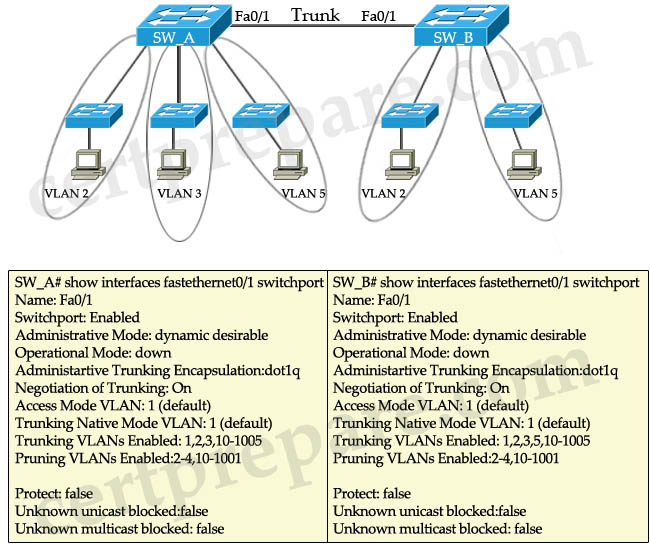
A. Configure the same number of VLANs on both switches.
B. Create switch virtual interfaces (SVI) on both switches to route the traffic.
C. Define VLAN 5 in the allowed list for the trunk port on SW_A.
D. Disable pruning for all VLANs in both switches.
E. Define VLAN 5 in the allowed list for the trunk port on SW_B.
Answer: C
Explanation
SW_A is missing VLAN 5 in the “Trunking VLANs Enabled”, that means the trunk link currently does not accept traffic from VLAN 5 to be sent on the link.
Question 7
Refer to the show interface Gi0/1 switchport command output shown in the exhibit. Which two statements are true about this interface? (Choose two)
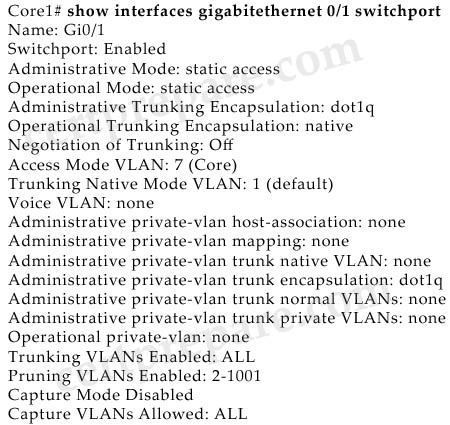
A. This interface is a member of a voice VLAN.
B. This interface is configured for access mode.
C. This interface is a dot1q trunk passing all configured VLANs.
D. This interface is a member of VLAN 7.
E. This interface is a member of VLAN 1.
Answer: B D
Question 8
In the three-layer hierarchical network design model; what’s associated with the access layer? (Choose two)
A. optimized transport structure
B. high port density
C. boundary definition
D. data encryption
E. local VLANs
F. route summaries
Answer: B E
Explanation
Main characteristics of three layers in the three-layer hierarchical network design model:
* Access layer:
+ Low cost per switch port
+ High port density
+ Scalable uplinks to higher layers
+ User access functions such as VLAN membership, traffic and protocol filtering, and quality of service (QoS)
+ Resiliency through multiple uplinks
* Distribution Layer:
+ Aggregation of multiple access-layer devices
+ High Layer 3 throughput for packet handling
+ Security and policy-based connectivity functions through access lists or packet filters
+ QoS features
+ Scalable and resilient high-speed links to the core and access layers
* Core layer:
+ Very high throughput at Layer 3
+ No costly or unnecessary packet manipulations (access lists, packet filtering)
+ Redundancy and resilience for high availability
+ Advanced QoS functions
Also, end-to-end VLANs and local VLANs belong to access layer.
Question 9
Refer to the following exhibits:
Exhibit #1
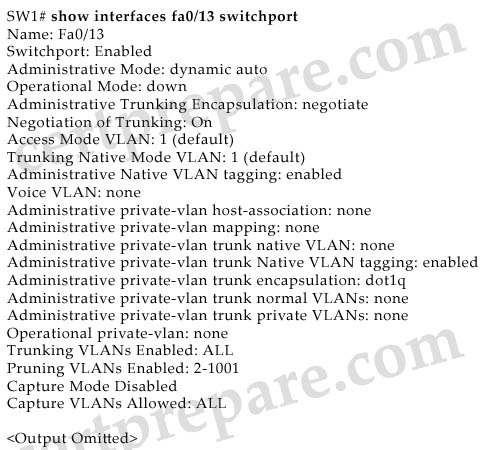
Exhibit #2
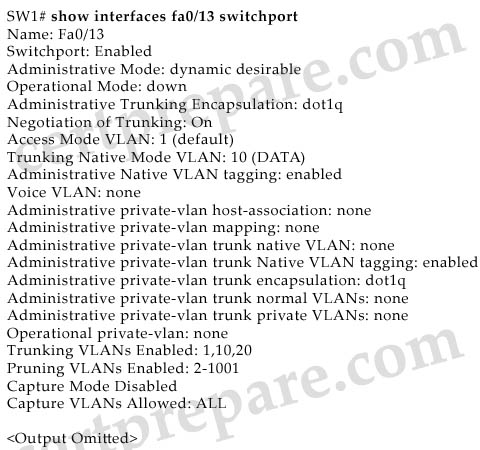
Study the exhibits carefully. The switchport output in Exhibit #1 displays the default settings of interface FastEthernet 0/13 on switch Sw1. Figure 2 displays the desired interface settings. Which command sequence would configure interface FastEthernet 0/13 as displayed in Exhibit #2?
A.
Sw1(config-if)# switchport trunk encapsulation dot1q
Sw1 (config-if)# switchport mode dynamic auto
Sw1 (config-if)# switchport trunk native DATA
Sw1 (config-if)# switchport trunk allowed vlan add 1,10,20
B.
Sw1(config-if)# switchport trunk encapsulation dot1q
Sw1(config-if)# switchport mode dynamic desirable
Sw1(config-if)# switchport trunk native vlan DATA
Sw1(config-if)# switchport trunk allowed vlan 1,10,20
C.
Sw1 (config-if)# switchport trunk encapsulation dot1q
Sw1 (config-if)# switchport mode trunk
Sw1 (config-if)# switchport trunk native DATA
Sw1 (config-if)# switchport trunk allowed vlan 1,10,20
D.
Sw1(config-if)# switchport trunk encapsulation dot1q
Sw1(config-if)#switchport mode dynamic desirable
Sw1(config-if)#switchport trunk native vlan 10
E.
Sw1 (config-if)# switchport trunk encapsulation dot1q
Sw1 (config-if)# switchport mode dynamic desirable
Sw1 (config-if)# switchport trunk native vlan 10
Sw1 (config-if)# switchport trunk allowed vlan 1,10,20
Answer: E
Question 10
What is the result of these commands?
| Switch (config)#interface range fa0/0-5 Switch(config-if-range)#switchport access vlan 2 |
A. Two new vlans are created on six switch ports
B. One new vlan is created on five switch ports
C. Six new vlans are created on six switch ports
D. One new vlan is created with the vlan number 2
Answer: D
Explanation
If the administrator has not created VLAN 2 before typing this command, a message will appear informing that VLAN 2 is created automatically.


